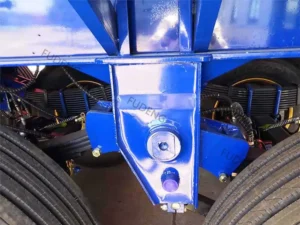In the field of automotive engineering, suspension systems are a key component of vehicle performance and ride comfort. Mechanical suspension and air suspension are two common suspension systems that have significant differences in design and functionality. This article will delve into the advantages and disadvantages of these two suspension systems, in order for consumers and car manufacturers to better understand their characteristics and applicable scenarios.
Part 1: Characteristics and advantages of mechanical suspension

Mechanical suspension is one of the widely used traditional technologies in the automotive industry. It is mainly composed of springs and shock absorbers to provide support and cushioning for the vehicle. The following are some characteristics and advantages of mechanical suspension:
- Cost effectiveness: Mechanical suspensions are usually relatively inexpensive, with lower manufacturing and maintenance costs, making them the preferred choice for most economy vehicles.
- Reliability: Due to the relatively simple nature of mechanical suspension systems, they typically perform well in terms of reliability. Its simple structure and fewer components reduce the possibility of malfunctions.
- Easy maintenance: The maintenance and repair of mechanical suspensions are relatively easy, and can be handled by ordinary vehicle repair shops. This reduces the complexity and cost of maintenance.
Part 2: Disadvantages and limitations of mechanical suspension
However, mechanical suspension also has some drawbacks, which may be limited in specific situations:
- Restricted adjustability: The adjustability of mechanical suspension is relatively limited, making it difficult to flexibly adjust the driving performance and suspension hardness of the vehicle.
- Not adapting to dynamic environments: Under different driving conditions, the response of mechanical suspension is relatively slow, making it difficult to adapt to rapidly changing road conditions.
Part 3: Characteristics and advantages of air suspension

In contrast, air suspension uses airbags and air compressors to adjust the suspension height of the vehicle by adjusting the air pressure of the airbags. The following are some characteristics and advantages of air suspension:
- Adjustable height: The air suspension allows the driver to adjust the height of the vehicle as needed, providing a more flexible driving experience. This is beneficial for achieving better fuel efficiency through different terrains.
- Excellent driving comfort: Air suspension can provide better shock absorption and a smoother driving experience. It is particularly effective in reducing bumps and vibrations, improving ride comfort.
Part 4: Disadvantages and limitations of air suspension
Although air suspension has many advantages, there are also some challenges:
- High cost: The manufacturing and maintenance costs of air suspension systems are relatively high, which makes them mainly used in high-end models and luxury cars.
- Complexity: Due to the complex airbags and electronic control systems involved in air suspension, repair and maintenance may require professional skills in the event of a malfunction.
Conclusion:
When choosing between mechanical suspension and air suspension, consumers need to consider their own needs and budget. Mechanical suspension is suitable for car owners who pursue cost-effectiveness and simple reliability, while air suspension provides a better choice for consumers who pursue excellent driving comfort and high adjustability.
Overall, mechanical suspension and air suspension have their own advantages and disadvantages, depending on individual driving needs and budget. With the advancement of technology in the future, these two suspension systems may further evolve and improve, providing consumers with more choices.
To stay abreast of the latest news, make sure to visit the Fudeng website or follow them on YouTube.
